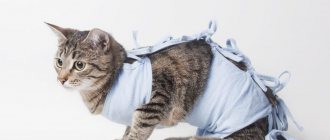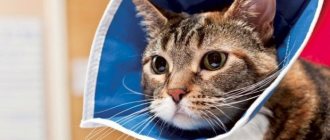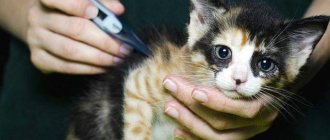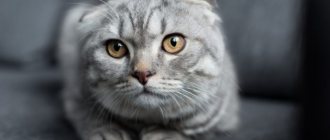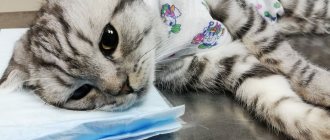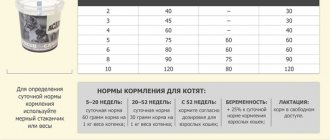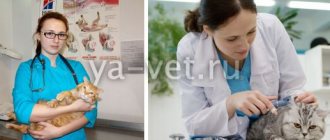Removing a cat's uterus is a standard procedure that is performed during the animal's puberty. Surgical intervention is not dangerous; the main condition is to provide adequate care for your pet after the operation.
The operation is recommended from the age of six months. To prepare the animal for surgery and anesthesia, it is recommended to undergo an examination, complete general and biochemical blood tests and visit a cardiologist.
The operation is performed under general anesthesia and involves the complete removal of the reproductive organs: the uterus and ovaries. There are various techniques for performing this operation. The difference lies in the type of surgical approach: the classic method with laparotomy access along the white line, the laparoscopic method and the method with removal of the uterus through a lateral approach.
It is also possible to apply different skin sutures: a regular suture, which must be removed after complete healing of the surgical wound, and an intradermal cosmetic suture, which simplifies postoperative care and does not require removal.
In the postoperative period, in order to minimize postoperative complications, it is important to treat the sutures with an antibacterial solution and cover them from licking by animals. For this purpose, special veterinary blankets and collars are used.
Also, due to a decrease in activity, most sterilized animals tend to gain weight. It is recommended to closely monitor this and, if necessary, switch the animal to a special diet.
Age for ovariohysterectomy
There is no consensus among veterinarians about the minimum age at which a cat can undergo hysterectomy. Most recommend intervention at 7-9 months, shortly before the first heat. Allegedly, early castration (from 3 months) causes disturbances in the functioning of the endocrine system, causes diseases of the kidneys, retina of the eyes, and contributes to the disproportionate development of the animal’s physique.
There is an opinion that it is better to remove reproductive organs after the onset of puberty, at about one year. But it’s worth delving into the processes occurring in the animal’s body. During a cat's first heat, her ovaries begin to work, producing estrogen. After lambing, other endocrine glands begin to produce hormones; the animal's restless behavior, caused by periodic hormonal changes, can persist long after the operation.
Practice shows that even at 3-4 months a cat tolerates anesthesia much easier than at 3-4 years. And any disruptions in the functioning of the systems at an older age may be caused not by the removal of the reproductive organs, but by other reasons.
It is worthwhile to dwell separately on sterilization of a pregnant cat. Veterinarians generally do not recommend this type of surgery, but it can be performed for medical reasons. In this case, the uterus and fetus are removed. It is necessary to understand that there is a possibility of high blood loss. In any case, the recovery period will be more difficult than with planned castration.
Simulation of sexual intercourse
The most modern method, which is successfully used for cats in the West, but is not yet widespread in Russia. It consists of two parts:
- direct simulation of sexual intercourse;
- taking sedatives.
This alternative to sterilization or castration involves influencing the genitals with a special instrument resembling a cotton swab. As a rule, it gives the best results in females, since during natural sexual intercourse they always have no eye contact with the male.
Among the advantages of this method are:
- complete absence of side effects and negative effects on the pet’s health;
- low cost;
- Possibility of use at home.
Disadvantages include:
- low efficiency in some cases;
- the need for several repeated sessions in a row over 5-10 days;
- short term effect.
In any case, it is important for cat owners to remember that using a chemical or radiation alternative to spaying and neutering should not be a step taken because they are tired of listening to the animal’s cries and enduring its deteriorating behavior. This should not be done under any circumstances, since all hormonal processes have already started and their sudden suppression is very detrimental to the health of the animal, and in some cases it can even cause disability. It is even more dangerous to use these methods repeatedly during active estrus. The owner is responsible for the life of the animal and must account for the consequences of such decisions.
In any case, when using any alternative to sterilizing a cat or male cat, detailed consultation with a veterinarian is necessary. Sometimes additional examination is required, including blood tests, listening to breathing and heart function.
Useful materials:
- Cutaneous horn General description of the disease Cutaneous horn on the forehead or face (ICD 10 code - L57.0) -...
- The cat has cancer Stages of mammary gland cancer in cats Like in humans, cat mammary cancer has ...
- Itching and odorless discharge Main causesBefore considering the factors that provoke the appearance of discharge that has a sour odor, it is necessary to immediately note...
- Normal temperature in animals Normal temperature in different types of animals Veterinary services Day hospital for animals Veterinary certificates Vaccination…
Preparing for surgery
In order for surgery to go smoothly, it is necessary to prepare the cat for surgery. The ideal option would be if the animal is fully vaccinated. Treatment for worms and external parasites is also necessary in advance. Depending on the patient’s health condition, the veterinarian may prescribe a general and biochemical analysis of blood, urine, and ECG. The list of prescriptions depends on the specific case.
To prevent vomiting and aspiration during anesthesia, the animal should not be fed for 8-12 hours before surgery. There is no need to shave your pet's belly in advance; this will be done immediately before surgery. Surgeries to remove the uterus in cats are simple, so no special long-term preparation is required.
Taking medications
Taking medications is used in cases where it is necessary to preserve the ability to bear offspring. This method gives the desired effect only in 15% of cases. Treatment with medications helps only at the first stage of the development of the disease; moreover, there is a high risk of relapse after recovery
The purpose of this treatment is to remove purulent masses from the uterus, get rid of bacteria and increase the animal’s immunity. Veterinarians prescribe the following medications:
- oxytocin or prostaglandin - these drugs cause contractions of the uterus and promote the release of pus, but they are used very carefully, since the wrong dosage causes uterine rupture and leads to death;
- Brullomycin - the drug is administered intramuscularly three times a day, 0.2-0.3 ml, the course of treatment is 2.5-3 weeks;
- cloprostenol - administered subcutaneously for 3 days at a dosage of 5 μg of the drug per 5 kg of weight;
- amoxicillin - combined with cloprostenol, the dosage is calculated as follows: per 1 kg of weight, 20 mg of the drug, injected into the muscle for a week;
- ceftriaxone is an antibiotic that is diluted in 5 ml of novocaine, administered intramuscularly, the dosage is selected by a veterinarian;
- To increase immunity, the cat is prescribed immunofan and ribotan, and fortified supplements are included in the diet.
Carrying out the operation
After preoperative anesthesia, the veterinarian will examine the animal. After this, the cat will be given a sedative, which will make the entrance to anesthesia smoother. When the animal relaxes under the influence of a sedative, an intravenous catheter is installed, through which an anesthetic agent is administered, and an infusion is performed (the introduction of an isotonic solution to maintain normal pressure).
After this, the fur on the belly is shaved and the skin is treated with an antiseptic. The operating table is being prepared. The animal is stretched, tied to it, and the surgical field is prepared again. Before the operation begins, the depth of anesthesia is checked. There are several ways: touch the corner of the eye or cornea, try to unclench your jaw, track your heart rate.
The first incision is made below the navel, the abdominal wall is incised along the linea alba. After opening the peritoneum, the veterinarian feels the uterus. Usually it is a thin thread and increases only with inflammation. Having found the organ, the surgeon moves it to the lumen of the surgical wound, the assistant removes the uterine horn, and the doctor places a ligature below the ovary.
After this, a clamp is applied to the ovary and uterus above the intended cutting site. This is done so that the blood in the horn does not spill after cutting. The same actions are repeated with the second horn of the uterus. Then the body of the organ is stretched out, the arteries feeding it are sutured, and ligatures are applied. After removal, the doctor sutures the abdominal wall, subcutaneous tissue and skin. The upper seam can be performed with either regular or self-absorbable threads. Typically its length is about 2 cm.
Symptoms
Signs of pyometra can be noticed approximately 2-4 weeks after estrus, and most often the disease begins acutely, with pronounced symptoms.
The main manifestations of the pathology are as follows:
- discharge from the loop of a brownish or cloudy white color with a thick consistency and unpleasant odor (occurs only when the cervix is open);
- lack of appetite, accompanied by severe thirst, vomiting, diarrhea;
- frequent urination;
- enlargement of the abdomen, uterus and genital organs, which can be noticed during visual inspection and palpation;
- deterioration in general health, fever, apathy or increased aggression.
Sometimes the disease develops so rapidly that the animal can die in a matter of days - the volume of purulent exudate reaches a liter in just a day, as a result of which the walls of the uterus rupture due to increased pressure, and fluid fills the abdominal cavity.
When the cervix is closed, the course of the disease can be hidden - the cat looks lethargic and apathetic, avoids active games and loses appetite, the coat becomes dull and disheveled. She can lick her belly often and for a long time, and when she tries to palpate or simply touch it, she shows great anxiety. If any of the above symptoms develop, you should immediately take the animal to a veterinary clinic, otherwise it may die.
To make a diagnosis of pyometra, the doctor performs a visual examination and palpation of the abdomen, after which he prescribes an ultrasound examination and blood tests. Ultrasound allows you to assess the size and extent of damage to the uterus - with the development of the pathological process, the organ greatly enlarges, its walls thicken, an accumulation of pus is observed in the cavity, and cysts and neoplasms appear on the surface. Blood tests reveal elevated levels of leukocytes, urea and protein, as well as a shift in the leukocyte formula to the left.
To diagnose purulent inflammation of the uterus, an ultrasound examination is performed on the animal. Using an ultrasound, the doctor examines the condition of the affected organ; with pyometra, the uterus becomes greatly enlarged, pus accumulates in it, cysts are visible on the surface, and the walls thicken.
The veterinarian will take the cat's blood for analysis. Hyperproteinemia, leukocytosis, hyperglobulemia, a shift to the left in the leukocyte formula, as well as an increase in urea (up to 300 mg) indicate the development of pyometra. An increased amount of protein is found in the urine (proteinuria).
Types of seams
In order to connect the cut tissues after surgery, special threads and suturing techniques are used after the cat is sterilized.
As for threads, there are two groups:
- Absorbable - these are usually used for internal sutures.
- Non-absorbable ones are an order of magnitude stronger than the previous ones. If the doctor has decided to use them internally, then they are additionally covered with a capsule.
When sterilizing a cat, there are the following types of sutures:
- Sutures that are placed on the peritoneum and abdominal muscles are usually called internal. They are not removed.
- External ones do not dissolve and require removal of the threads after 10-12 days.
- A cosmetic stitch involves the use of self-dissolving threads and does not require further processing or removal. Accordingly, a cosmetic suture is preferable when sterilizing cats. A cosmetic suture is used during laparoscopy.
Should a cat be allowed to give birth before being spayed?
NO! If you do not plan to breed cats, then it is better to carry out the operation as early as possible, without allowing the cat to be mated. Moreover, you should not specially knit it, knowing that you will sterilize it later.
After the cat has lambed, sex hormones begin to be produced not only by the ovaries, but also by other endocrine glands, and sexual behavior can persist for a long time, if not forever, and then it is most likely impossible to avoid the manifestation of sexual heat after sterilization.
Is it necessary to remove the uterus?
Previously, the issue of removing the uterus during sterilization was raised. Still, is it necessary to cut out the uterus? The answer is rather positive.
It is better to remove the uterus, because after sterilization the body no longer needs the uterus, and it often happens that it becomes inflamed (endometritis), or purulent contents accumulate in it (pyometra), or, even worse, malignant tumors may appear. And if the uterus was removed during sterilization, then these problems do not arise due to its absence.
Important!
Many cat owners, due to their illiteracy, are convinced that a cat should “experience the joy of motherhood” at least once in its life.
Postoperative care
After the operation is completed, the animal will remain in a semi-conscious state for some time. Cats usually have poor coordination of movements and stagger when walking. Your pet may not be able to use the litter box for the first time. You shouldn’t scold her, it’s all to blame for the anesthesia. It is necessary to provide your pet with maximum peace. Find a place for her away from drafts and cover her - after surgery, the cat’s thermoregulation is temporarily disrupted and she will freeze. You can additionally warm the animal with a heating pad, but place it on the back, not the stomach.
To prevent bacterial infection of the suture area, it is recommended to put a blanket on the cat. It is a fabric “overall” with ties. The blanket will prevent the cat from licking the incision site. The seam is treated once a day with a chlorhexidine solution.
As a rule, there is no pain after removal of the reproductive organs, or they are observed on the first day. But the pain is minor and does not require the use of potent drugs. Basically, the postoperative period lasts a couple of days and is characterized by weakness, drowsiness, and poor appetite. After this time, the cat returns to normal life.
It must be taken into account that after removal of the uterus, a cat’s metabolism slows down and its appetite increases, which can lead to obesity. Therefore, it is necessary to reconsider the pet’s diet, perhaps switching it to another food. Also spend time playing with your pet to ensure she gets enough physical activity.
As after any operation, complications are possible after castration. The risk of their development increases in weakened, aged animals, as well as in obese cats. If there is poor coagulation of blood vessels or incorrect application of threads, bleeding into the abdominal cavity is possible. Its signs are refusal to lie on the stomach on the third day after surgery and later, severe pain, refusal to eat, and loud meowing. In this case, a second operation is required, during which all blood clots are removed.
If the seam becomes dirty, it may fester. In this case, you must immediately contact a veterinarian to avoid severe infection. Otherwise, the wounds will not heal on their own, you will have to remove the stitches, remove dead skin and stitch them up again. The best prevention of suture suppuration is treatment according to the recommendations of the treating veterinarian and wearing a blanket until complete healing.
Sometimes a “bump” forms at the site of the suture; this is not considered a pathology and is associated with the individual characteristics of the animal, or more precisely, with tissue healing. A couple of months after the operation, the lump will become invisible.
The main rule for the owner of an operated cat is to be attentive to the pet. Do not be afraid to call the doctor at the slightest suspicion of an abnormal condition of the animal; if necessary, the veterinarian will give recommendations or offer to conduct an examination.
Conclusion
The main “side effect” of castration is a change in metabolism, which creates the likelihood of obesity. After the operation, the owner will need to be more attentive to the cat’s diet and monitor its excess weight. However, it is not at all necessary that your cat will gain excess weight after surgery. If an animal leads an active lifestyle and eats properly, then nothing threatens its slender figure.
Thus, sterilization is not a dangerous operation, but it is an important and necessary procedure for a happy life for the animal and its owner.
Sources:
https://moypitomec.ru/koshki/zabolevaniya/operacija-po-udaleniju-matki-u-koshki.html https://healthy-animal.ru/article/ovariogisterektomiya-dlya-koshek/ https://lapulik.com /o-koshke/uhod/sterilizacija/likbez-po-koshek.html
Types of operational access
Before considering the types of sutures, let's talk about what types of surgical access, i.e. choice of puncture site and access to the abdominal cavity exist. The following types of operational access are known:
The linea alba is the most common. The incision is made along the midline of the abdomen. First, the skin is incised, then the tendon of the abdominal muscles, and then the peritoneum.
Along the side line. The incision on the side is 1-3 cm in the area of the lumbar vertebrae.
Laparoscopy is one of the most modern types of operations. The operation is performed both along the white line of the abdomen and on the side. Veterinarians agree that this is a minimally traumatic method. Again, both the uterus and ovaries are removed. In addition to solving the problem of sterilization, during the operation the veterinarian also has the opportunity to examine a number of the cat’s internal organs.
Contraindications to laparoscopic sterilization are diseases of the uterus, large cysts and ovarian tumors, pregnancy, severe adhesions in the abdominal cavity, diaphragmatic hernia, trauma to the diaphragm, obesity.
If there are contraindications, sterilization is performed along the white line of the abdomen.
There is also an option through an ultra-small incision: an incision is made, after which a small surgical hook is inserted, the ligament is lifted, and then the ovary is removed. After suturing, only the ovary and some part of the ligament are removed. In some cases, the uterus is also completely stretched out and removed.
How is cats sterilized and how to care for your pet after surgery?
Removing a cat's uterus is a standard procedure that is performed during the animal's puberty. Surgical intervention is not dangerous; the main condition is to provide adequate care for your pet after the operation.
The operation is recommended from the age of six months. To prepare the animal for surgery and anesthesia, it is recommended to undergo an examination, complete general and biochemical blood tests and visit a cardiologist.
The operation is performed under general anesthesia and involves the complete removal of the reproductive organs: the uterus and ovaries. There are various techniques for performing this operation. The difference lies in the type of surgical approach: the classic method with laparotomy access along the white line, the laparoscopic method and the method with removal of the uterus through a lateral approach.
It is also possible to apply different skin sutures: a regular suture, which must be removed after complete healing of the surgical wound, and an intradermal cosmetic suture, which simplifies postoperative care and does not require removal.
In the postoperative period, in order to minimize postoperative complications, it is important to treat the sutures with an antibacterial solution and cover them from licking by animals. For this purpose, special veterinary blankets and collars are used.
Tips for caring for your cat after sterilization
You can talk about the procedure for sterilizing cats for a long time, listing all the advantages and disadvantages of this operation, but if the owner of a furry pet still decides to take this measure, then you definitely need to find out what care for the cat after sterilization involves.
Sterilization or castration?
First of all, the owner of the animal should decide what to do: sterilization or castration. These two procedures are different from each other. In the first case, the ovaries are ligated or the uterus is removed, but the ovaries are not touched. With this operation, estrus continues, but there cannot be kittens. The animal's hormonal levels subsequently become unstable and even in rare cases pregnancy is possible.
How is the operation performed?
During the operation, the animal is under general anesthesia. Seam position may vary. This can be like an incision along the linea alba or a small one on the side. In the first case, such a suture is made if there is inflammation. In the second, the operation is performed during early castration.
The second operation is much easier. In any case, the incision site must be constantly treated.
Preparation before surgery
It is important to properly prepare the animal for sterilization.
To do this you need:
- examine it in the clinic: the veterinarian must make sure that the animal is healthy;
- pass the necessary tests;
- give the animal anti-flea and worm medication a week before surgery;
- trim the cat’s claws so that after sterilization she cannot injure the incision;
- do not feed the animal 10-12 hours before surgery.
